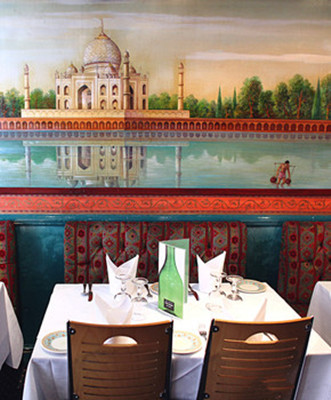餐館
Giving up the gosht
放棄印式
The future of curry houses looks grim
咖喱屋的未來看起來很嚴峻
THE curry house is a British institution. Every town has at least one. Ballater, a tiny village in the icy remoteness of northernScotland, boasts two. It is also the economic bulwark of a community. Bangladeshis run most of the country's Indian restaurants, and they depend heavily on the trade. Fully 42% of working-age Bangladeshi men toil in restaurants. But changes in eating habits, immigration rules and growing aspirations add up to trouble for the industry.
咖喱屋是英國的習俗。每個鄉鎮至少都有一個。在寒冷的蘇格蘭北部偏遠的一個小村莊—巴拉特,擁有兩家。這也是一個社會的經濟堡壘。孟加拉國人經營著英國多數的印度餐館,他們在很大程度上依賴于貿易。孟加拉國42%的處于勞動年齡的男子都在餐館中勞碌。但是英國民眾飲食習慣的改變、現行的英國移民政策以及孟加拉國民對刺激日益增長的熱情,都為行業發展增添了困難。

Following the financial crisis, people cut back on eating out but ordered more takeaways, says Oli Khan, a Bangladeshi chef who owns four establishments. Now even the takeaway trade is struggling. A quarter of curry-lovers say they have swapped restaurant meals or takeaways for supermarket ready meals. Spending on poppadums rose by 40% between 2009 and 2013, according to Kantar Worldpanel, a research firm.
擁有四個場所的孟加拉國廚師—奧利汗表示,在金融危機之后,人們減少了外出就餐,但增加了叫外賣的次數。現在連外賣行業都是夾縫求生。有四分之一的咖喱愛好者表示,他們已經不再餐廳用餐或叫外賣,而是吃超市現成的飯菜。Kantar Worldpanel表示,2009至2013年間印度薄餅的銷售量增長了40%。
Indian restaurants have missed the trend for casual dining, says Helena Spicer, an analyst at Mintel, another market researcher. Other eateries focus on particular groups of diners—the rushed, the monied—but curry houses try to appeal to everyone. Rising food and gas bills are eating into profits. Most are independent so reap none of the benefits of economies of scale. Nor can they run big marketing campaigns.
另一家市場研究公司—敏特公司的分析師海倫娜斯派塞分析:印度餐館已經偏離了休閑餐飲的主流。其它的一些餐館關注于特定食客群體,匆忙的,有錢的,但是咖喱屋試圖做到面向大眾。上漲的食品費和燃氣費正在抵消所獲利潤。大多數餐館都是獨立經營所以沒有從規模經濟中獲得的好處。當然也不可能經營大型市場營銷活動。
And staff costs are soaring. “Chefs have become like gold dust,” says Enam Ali, a restaurateur and founder of the British Curry Awards. Importing them has been made difficult. Visa rules mean chefs must speak English and earn at least 20,300 (32,500) a year. On Caterer.com, a recruitment site for the hospitality industry, salaries for chefs with three years' experience specialising in Indian food start at 13,500. Chefs are on the government's “occupation shortage” list, but only if the job demands five years' experience, pays at least 29,570 and is not in an establishment which provides a takeaway service. That rules out most curry houses.
員工成本也在大幅攀升。英國咖喱獎的創始人同時也作為餐館老板的Enam Ali表示, “廚師異常珍貴,將他們引入是個難題。簽證規則意味著廚師必須會說英語”,并且一年內至少要賺20,300(32,500)。在Caterer.com—一個為酒店業服務的招聘網站上寫著,專攻印度菜并且擁有三年工作經驗的廚師起薪為13,500。:廚師這一職業已登上政府的職業人才短缺表,但該短缺也僅限于那些有五年以上工作經驗、起薪29570英鎊以及不提供外賣服務的餐廳,所以咖喱屋就不屬于該范疇之內了。
Some reckon the answer is teaching natives to cook chicken tikka masala. But they are reluctant. The Hospitality Guild runs six-week training courses at three colleges that lead to year-long apprenticeships. So far just 15 people have gone on to apprenticeships, not all as chefs. Ranjit Mathrani, who runs several posh Indian restaurants and a small chain of cheaper ones, offers traineeships. Not a single white Briton has applied.
一些人認為解決問題的辦法就是交本地人煮瑪莎拉雞。但他們都很不情愿。好客的工會在三所學院里進行了為期六周的學徒培訓課。目前為止,僅有15人到達了學徒程度,不是所有人都是廚師。經營著幾家豪華印度餐廳和價格相對低廉的小型連鎖餐館的店主Ranjit Mathrani表示他愿意提供實習機會。然而沒有一個純英國人報名。
Nor are young British Asians filling the gap. Although still huge, the proportion of Bangladeshi men who work in restaurants is falling: in 2004 it was 55%. The young know that they can do better. Their performance at school is steadily improving: in 2011 they outperformed whites, getting more good GCSEs, the exams normally taken at 16. They want to become journalists and lawyers, says Mr Ali, not chefs. Good for Bangladeshis. Too bad for British curry-lovers.
也并沒有亞裔年輕人來填補這一空缺。盡管比重仍大,孟加拉國男性在餐館工作的比例持續下降:2004年為55%。年輕人知道他們可以做的更好。他們在學校的表現正在逐步提高:在2011年他們的表現比白人還好,參加了更多優秀的英國普通初級中學文憑課程(GCSEs)—一般來說考16門。Enam Ali說他們想成為記者和律師而不是廚師。對于孟加拉人來說這是個好消息,但對于英國的咖喱愛好者來說這再壞不過了。 翻譯:黃佳欣 校對:尤熠












